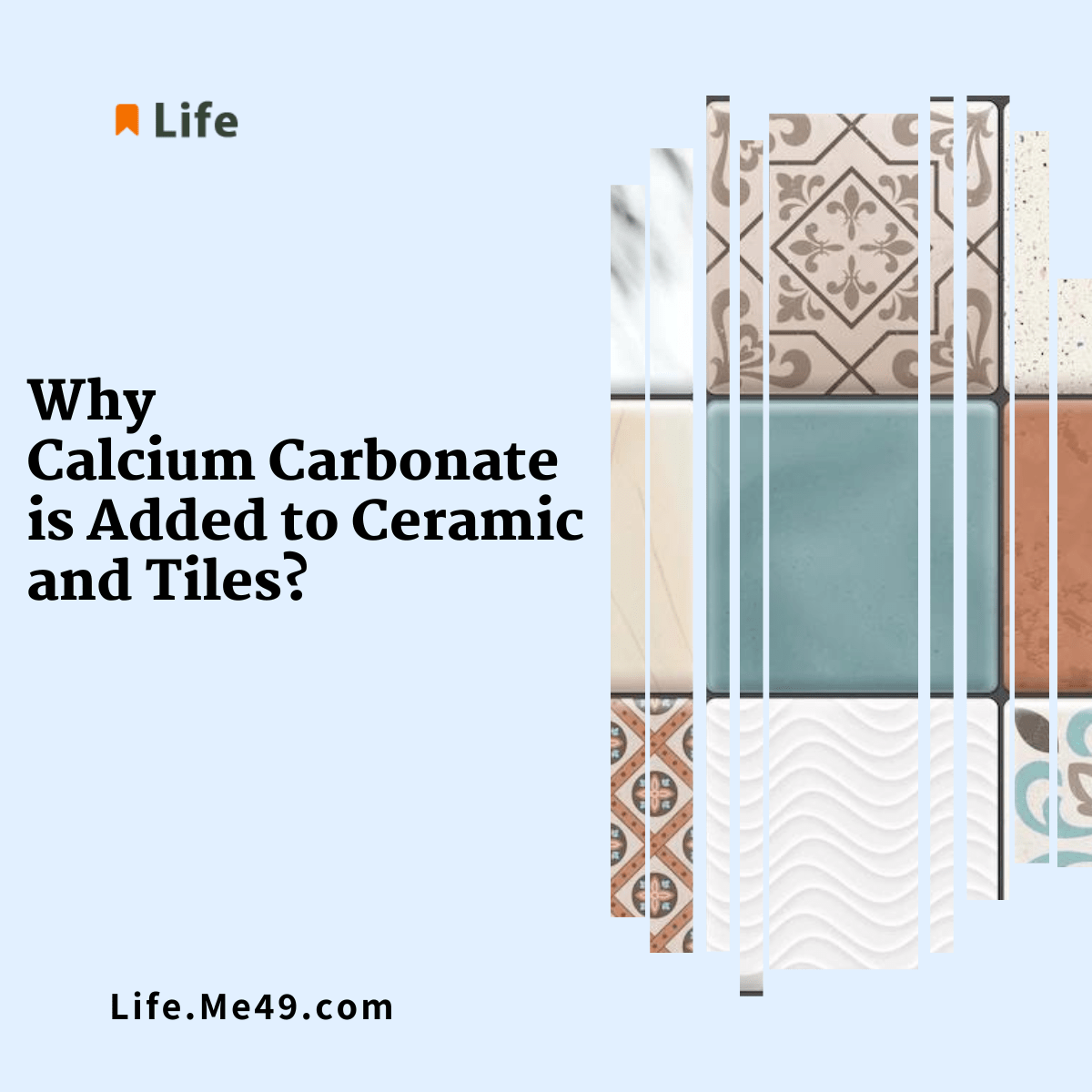Why Calcium Carbonate is Added to Ceramic and Tiles?
In the world of ceramics and tiles, the addition of calcium carbonate is a topic of much debate and discussion.
Manufacturers and artisans often weigh the pros and cons of using this compound in their creations.
In this comprehensive guide, we will delve deep into the reasons why calcium carbonate is added to ceramic and tiles, exploring its roles, effects, and applications in these industries.
Cons and Pros of Using Calcium Carbonate in Ceramic
Is Calcium Carbonate Used to Make Ceramic?
Yes, calcium carbonate is commonly used in ceramic production. This versatile compound plays a pivotal role in shaping the characteristics of ceramic products.
But what are the advantages and disadvantages of incorporating calcium carbonate into ceramics?
Pros:
- Enhanced Durability: Calcium carbonate reinforces the structure of ceramic, making it more durable and less prone to breakage.
- Cost Efficiency: It is a cost-effective filler material that helps reduce production expenses.
- Improved Whiteness: Calcium carbonate contributes to the overall whiteness of ceramic products, enhancing their aesthetic appeal.
- Controlled Shrinkage: It aids in controlling the firing shrinkage of ceramics, ensuring uniform dimensions.
Cons:
- Reduced Flexibility: Excessive use of calcium carbonate can make ceramics more brittle.
- Impact on Color: While it enhances whiteness, it may also dilute the vibrant colors in ceramic designs.
- Cracking Risk: Over-reliance on calcium carbonate without proper formulation can lead to cracking during firing.
The Roles of Calcium Carbonate in the Ceramic Sector
The incorporation of calcium carbonate into ceramics serves several crucial purposes:
How does Calcium Carbonate Act as a Filler Material in Ceramic Production?
Calcium carbonate plays a crucial role as a cost-effective filler material in ceramic production.
This is especially significant in the realm of cost management, as it allows manufacturers to reduce their reliance on expensive clay.
In practical terms, this means savings on raw material costs without compromising the structural integrity of the final product.
By minimizing the need for costly clay, manufacturers can achieve a more sustainable and economically viable production process.
This dual benefit of cost-effectiveness and sustainable practice makes calcium carbonate an indispensable component in the ceramic industry.
Furthermore, its role as a filler material extends beyond cost savings.
It provides a backbone for ceramics, contributing significantly to their strength and overall integrity.
This is a boon for artisans and manufacturers, allowing them to create ceramics that are not only economically efficient but also structurally robust, meeting the highest quality standards.
How does Calcium Carbonate Function as a Whitening Agent in Ceramics?
One of the remarkable attributes of calcium carbonate in ceramics is its capability to serve as a whitening agent.
This function holds immense importance in enhancing the visual appeal of ceramic products.
The compound imparts a consistent, bright, and uniform white color to ceramics, effectively elevating their aesthetic charm.
This whitening effect is particularly desirable in products where a pristine, elegant appearance is paramount, such as fine china and porcelain.
This characteristic allows artisans and manufacturers to create ceramic items with a timeless and classic white finish.
This not only enhances their market desirability but also increases their artistic value.
Calcium carbonate’s role as a whitening agent is, therefore, indispensable in the ceramic industry.
It ensures that ceramic creations stand out for their elegance and sophistication, meeting the discerning tastes of customers who seek both visual allure and quality craftsmanship.
How does Calcium Carbonate Regulate Firing Shrinkage in Ceramic Production?
Regulating firing shrinkage is a critical aspect of calcium carbonate’s involvement in ceramic production.
This compound plays a pivotal role in maintaining the dimensional stability of ceramics.
During the firing process, ceramics are subjected to extreme heat, which can cause them to undergo shrinkage.
However, calcium carbonate acts as a stabilizing force, ensuring that this shrinkage is controlled and consistent.
This control is essential to prevent deformities and ensure that the final product adheres to precise design specifications.
It provides manufacturers with the ability to produce ceramics with dependable and uniform dimensions, meeting the expectations of both artisans and customers alike.
The ability to control shrinkage is, therefore, a fundamental advantage of incorporating calcium carbonate into ceramic production.
Additional Benefits of Calcium Carbonate’s Role in Controlling Shrinkage:
- Reduced Product Defects: By preventing excessive shrinkage, calcium carbonate contributes to a reduction in defects during firing.
- Enhanced Manufacturing Precision: Manufacturers can achieve a higher degree of precision in producing ceramics with intricate designs and specifications.
- Improved Consistency: The compound ensures that each ceramic piece maintains its intended dimensions, resulting in a uniform and visually appealing final product.
What are the Effects of Calcium Carbonate in Ceramic?
The presence of calcium carbonate in ceramic compositions results in the following effects:
How does Calcium Carbonate Provide Mechanical Reinforcement in Ceramic Production?
Calcium carbonate serves as a mechanical reinforcement agent in ceramic production.
This role is pivotal in enhancing the overall structural integrity of ceramics, making them more resilient and capable of withstanding physical stress.
The compound acts as a strengthening agent, fortifying the ceramic structure and reducing its susceptibility to breakage and damage.
This mechanical reinforcement is particularly valuable in the ceramic industry, where durability is a key consideration.
Manufacturers and artisans benefit from the added assurance that their ceramic products will maintain their shape and strength even under challenging conditions.
Calcium carbonate’s contribution to mechanical reinforcement ensures that ceramic creations are not only visually appealing but also built to last.
Additional Advantages of Mechanical Reinforcement by Calcium Carbonate:
- Extended Lifespan: Ceramics fortified with calcium carbonate have a longer lifespan, making them ideal for long-term use.
- Reduced Maintenance: The increased durability translates to reduced maintenance and replacement costs.
- Enhanced Versatility: The strengthened ceramic can be used for a wider range of applications, including heavy-duty purposes.
How does Calcium Carbonate Enable Cost Reduction in Ceramic Production?
An essential benefit of calcium carbonate in ceramic production is its ability to facilitate cost reduction.
This compound offers a cost-effective solution by allowing manufacturers to reduce their consumption of expensive clay.
In practical terms, this translates into significant savings on raw material costs without compromising the quality or performance of the final ceramic product.
Manufacturers can optimize their production processes by incorporating calcium carbonate, thereby achieving a more sustainable and economically viable approach.
This dual advantage of cost-efficiency and sustainability makes calcium carbonate an invaluable component in the ceramic industry, aligning economic benefits with environmental responsibility.
Additional Cost-Reduction Benefits of Calcium Carbonate:
- Lower Production Costs: The reduced reliance on costly clay materials leads to lower overall production costs.
- Competitive Pricing: Manufacturers can offer ceramics at competitive prices, widening their customer base.
- Environmental Impact: By reducing clay consumption, the environmental impact associated with clay extraction is diminished, contributing to sustainability efforts.
How does Calcium Carbonate Contribute to Consistency in Ceramic Production?
Consistency is a hallmark of quality in ceramic production, and calcium carbonate plays a crucial role in maintaining consistent product dimensions.
This is vital for manufacturers and artisans who require precision in their ceramic creations.
The compound’s ability to regulate firing shrinkage ensures that each ceramic piece maintains its intended dimensions, resulting in a uniform and visually appealing final product.
By reducing variability in size and shape, calcium carbonate ensures that every ceramic piece meets the same high standards of quality.
This consistency is essential for industries that rely on precise specifications, such as architectural ceramics and industrial applications.
Additional Benefits of Consistency Enabled by Calcium Carbonate:
- Ease of Installation: Uniform ceramic dimensions make installation easier, especially for large-scale projects.
- Reduced Wastage: Minimized size variations reduce wastage during production, contributing to cost-efficiency.
- Enhanced Customer Satisfaction: Consistent ceramics meet customer expectations, leading to higher satisfaction rates.
How does Calcium Carbonate Contribute to Aesthetic Enhancement in Ceramic Production?
Aesthetic appeal is a defining characteristic of ceramics, and calcium carbonate plays a significant role in aesthetic enhancement.
The compound contributes to the appealing whiteness of ceramics, making them visually striking and desirable.
This whiteness is especially important in ceramic products where a pristine, elegant appearance is paramount, such as fine china and porcelain.
Artisans and manufacturers benefit from the ability to create ceramic items with a timeless and classic white finish, increasing their market desirability and artistic value.
Calcium carbonate’s role as an aesthetic enhancer ensures that ceramic creations not only meet high-quality standards but also captivate the eye with their elegance and sophistication.
Additional Benefits of Aesthetic Enhancement by Calcium Carbonate:
- Increased Market Appeal: Whiter ceramics have broader market appeal, attracting a wider range of customers.
- Versatile Design Options: The enhanced whiteness provides a neutral canvas for various design possibilities.
- Premium Quality Perception: Aesthetically pleasing ceramics are often associated with higher quality, elevating brand image.
Cons and Pros of Using Calcium Carbonate in Tiles
Is Calcium Carbonate Used to Make Tiles?
Yes, calcium carbonate is a common ingredient in tile manufacturing.
Tiles, whether for floors or walls, often benefit from the inclusion of this compound. Let’s examine the advantages and disadvantages.
Pros:
- Increased Toughness: Tiles with calcium carbonate are more robust and less prone to chipping or cracking.
- Economical: It reduces the cost of production, making tiles more affordable.
- Aesthetic Appeal: Calcium carbonate enhances the visual appeal of tiles, especially in terms of color and brightness.
- Uniform Sizing: The compound helps maintain consistent tile dimensions.
Cons:
- Brittleness: Excessive use of calcium carbonate can make tiles brittle, leading to breakage.
- Color Dilution: While it brightens tiles, it may diminish the intensity of certain colors.
- Firing Challenges: Improper incorporation can result in firing-related issues.
The Roles of Calcium Carbonate in the Tiles Sector
In the world of tiles, calcium carbonate plays vital roles:
- Cost-Effective Filler: It serves as a filler material, reducing the reliance on more expensive components.
- Color Enhancement: Calcium carbonate contributes to the vibrancy and brightness of tile colors.
- Enhanced Strength: Tiles with calcium carbonate withstand wear and tear better.
What are the Effects of Calcium Carbonate in Tiles?
The presence of calcium carbonate in tile production leads to the following effects:
- Strengthened Structure: Tiles become more resilient and long-lasting.
- b: Manufacturers can create affordable yet high-quality tiles.
- Consistent Dimensions: Calcium carbonate ensures uniform tile sizing.
- Aesthetic Improvement: It adds visual appeal to tiles, making them more attractive.
Effect of Carbonates on Firing Shrinkage
Calcium carbonate’s influence on firing shrinkage is a critical aspect of its application in ceramics and tiles.
How Does Calcium Carbonate Affect Firing Shrinkage?
Calcium carbonate helps control firing shrinkage in the following ways:
- Dimensional Stability: It prevents excessive shrinkage, ensuring that ceramic and tile products maintain their intended dimensions.
- Uniformity: The compound contributes to consistent shrinkage across the entire product, reducing defects.
Whiting Calcium Carbonate in Ceramic and Tiles
What is Whiting Calcium Carbonate?
Whiting calcium carbonate is a specific type of calcium carbonate used in ceramics and tiles. It is known for its high purity and fine particle size, making it ideal for achieving certain properties.
The Benefits of Whiting Calcium Carbonate
- High Purity: Whiting calcium carbonate is exceptionally pure, minimizing impurities in ceramic and tile formulations.
- Improved Fineness: Its fine particle size enhances the smoothness and texture of the final product.
- Consistency: Whiting calcium carbonate contributes to the uniformity of ceramics and tiles.








